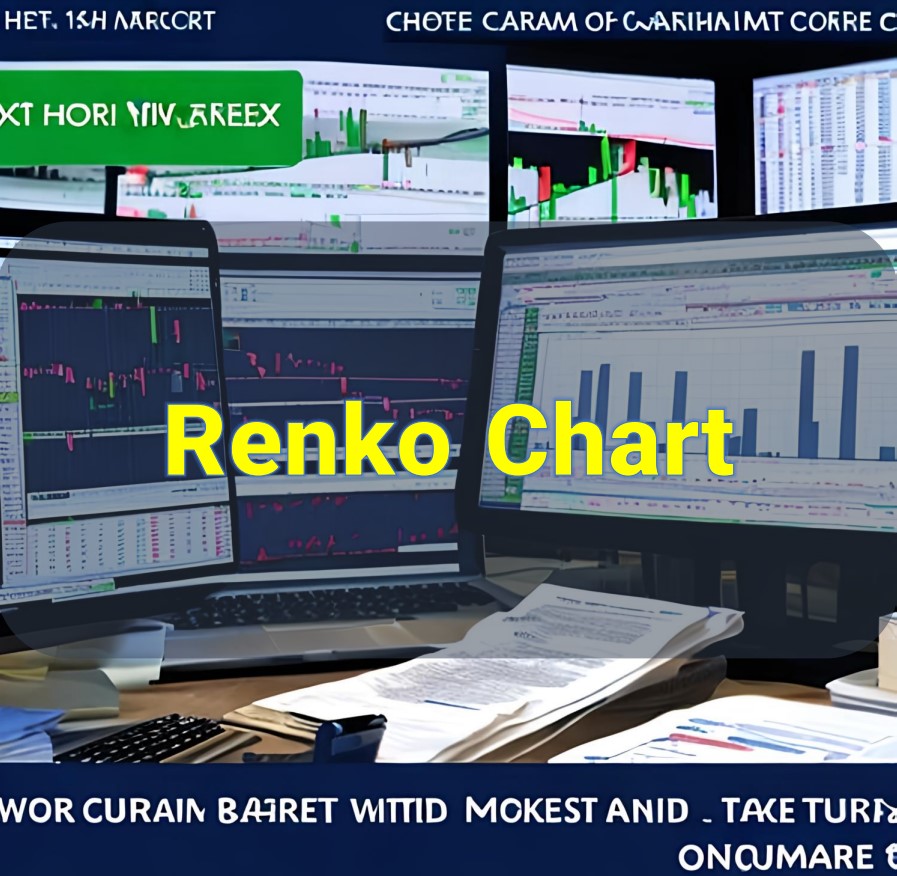Renko Chart – When it comes to technical analysis in the world of trading and investing, there are various charting methods available to traders. One such method is the Renko chart. Renko charts provide a unique perspective on price action, helping traders identify trends, key levels, and potential trading opportunities. In this article, we will explore the Renko chart in detail, discussing its origins, construction, interpretation, and the benefits it offers to traders.
What is a Renko Chart?
A Renko chart is a type of charting method used in technical analysis that focuses solely on price movements, disregarding time and volume. The word “Renko” is derived from the Japanese word “renga,” meaning “brick.” Just like its name suggests, Renko charts consist of blocks or bricks that represent price movements.
How Does a Renko Chart Work?
Renko charts work by focusing solely on price movements and disregarding time intervals. They are constructed by plotting bricks or blocks on a chart, representing price changes. Unlike traditional candlestick charts, which use time as a reference, Renko charts only form new bricks when the price surpasses a predefined threshold.
To understand how Renko charts work, imagine a stock that is currently trading at $100. Let’s say the trader sets the brick size at $2. This means that a new brick will be formed only when the price moves up or down by $2 or more.
If the price of the stock rises to $102, a new brick will appear on the chart. The brick’s color and direction will depend on the chosen representation: for example, green for an upward movement and red for a downward movement. The size of each brick remains constant, in this case, $2.
Now, let’s assume the stock price continues to rise and reaches $105. Since the price has surpassed the previous brick’s size of $2, another brick will be added to the chart. This process continues as the price moves further, forming a series of bricks that represent significant price movements.
Conversely, if the stock price starts to decline and reaches $98, a new brick will form on the chart, representing the downward movement. The bricks will continue to form and stack accordingly as the price fluctuates.
Renko charts provide a visual representation of price action, focusing on substantial price movements rather than minor fluctuations. By eliminating the time element, Renko charts simplify the analysis of trends, support and resistance levels, and reversal patterns.
It’s important to note that the brick size in Renko charts can be adjusted by the trader based on their preference and the specific asset being analyzed. Different brick sizes can provide different levels of sensitivity to price movements, allowing traders to tailor their analysis to their trading style and objectives.
Constructing a Renko Chart
To construct a Renko chart, follow these steps:
1. Choose the Brick Size: The brick size determines the price movement required to form a new brick on the chart. Select a suitable brick size based on the asset being analyzed and your trading strategy. A smaller brick size captures more price movements, while a larger brick size filters out smaller fluctuations.
2. Identify the Starting Point: Determine the starting point of your Renko chart. This can be the opening price of the asset or any other reference point you prefer.
3. Plot the Bricks: Start plotting the bricks on the chart based on the price movements. If the price surpasses the brick size in an upward direction, a new brick is added above the previous one. If the price drops below the brick size, a new brick is added below the previous one.
4. Define the Brick Color: Assign a specific color to each brick based on its direction. Typically, green or white is used to represent upward movements, while red or black represents downward movements. This color coding enhances the visual representation of the chart.
5. Continue the Construction: Keep adding bricks to the chart as price movements occur. Each brick represents a fixed price range based on the chosen brick size.
6. Analyze the Chart: Once the Renko chart is constructed, analyze it for patterns, trends, and key levels. Pay attention to the formation of consecutive bricks in the same direction, as it indicates a prevailing trend. Also, identify support and resistance levels based on brick reversals.
Remember, Renko charts focus solely on price movements and eliminate the element of time. This unique characteristic helps traders identify trends and significant price levels with greater clarity. By observing the bricks’ direction and pattern formations, traders can make informed decisions in their technical analysis and trading strategies.
Understanding Renko Chart Patterns
Renko charts exhibit various patterns that can provide valuable insights into price trends and potential trading opportunities. These patterns can be categorized into basic Renko patterns and advanced Renko patterns.
Basic Renko Patterns
The basic Renko patterns include trends, reversals, and consolidations. Trend patterns indicate the overall direction of the market, while reversal patterns suggest a potential change in the trend. Consolidation patterns occur when the market enters a period of sideways movement.
Advanced Renko Patterns
Advanced Renko patterns involve more complex formations such as
double tops and bottoms, triangles, and channels. These patterns can provide traders with additional signals for making informed trading decisions.
Using Renko Charts in Technical Analysis
Renko charts offer several advantages for technical analysis and can be a valuable tool for traders. Here are some key applications of Renko charts:
Trend Identification
Renko charts excel at identifying trends due to their ability to filter out market noise. Traders can easily spot the direction of the trend by observing the series of bricks and their colors (typically green for bullish and red for bearish).
Support and Resistance Levels
Renko charts help identify key support and resistance levels as these levels often act as turning points for price movements. Traders can use these levels to plan their entry and exit points more effectively.
Breakout Trading
Breakout trading is a popular strategy among traders, and Renko charts can enhance the effectiveness of this approach. By focusing on significant price movements, Renko charts provide clearer breakout signals, allowing traders to capitalize on price breakouts.
Stop Loss Placement
Renko charts offer a unique advantage when it comes to setting stop-loss levels. Since Renko charts filter out noise and emphasize price trends, stop-loss levels can be placed more effectively, reducing the chances of premature stop-outs.
Advantages of Renko Charts
Renko charts come with several advantages that make them appealing to traders:
– Simplified price analysis by removing time-based noise
– Enhanced trend identification and trend-following capabilities
– Clearer visualization of support and resistance levels
– Effective filtering of market noise and false signals
– Suitable for various financial markets, including stocks, forex, and cryptocurrencies
Limitations of Renko Charts
While Renko charts offer numerous benefits, it is important to be aware of their limitations:
– Lack of detailed time information, which may be essential for some trading strategies
– Difficulty in identifying intraday price fluctuations and smaller-scale market movements
– The reliance on fixed brick sizes, which may not suit all market conditions
– Possible discrepancies when comparing Renko chart patterns with traditional candlestick patterns
Renko Chart Strategies
Traders have developed various strategies based on Renko charts. Here are two common approaches:
Trend-Following Strategies
Trend-following strategies involve identifying and trading in the direction of the prevailing trend. Traders can use Renko charts to spot trends and ride them until signs of reversal or exhaustion appear.
Reversal Strategies
Reversal strategies aim to capture trend reversals and trade in the opposite direction. Renko charts can help identify potential reversal signals, such as double tops or bottoms, providing traders with opportunities to profit from price reversals.
Renko Chart Software and Platforms
Several trading platforms and charting software offer Renko charts as a built-in feature. Traders can choose from a wide range of options, both free and paid, depending on their specific needs and preferences.
Conclusion
Renko charts provide traders with a unique perspective on price movements, offering a simplified yet powerful tool for technical analysis. By filtering out noise and focusing solely on price action, Renko charts enable traders to identify trends, support and resistance levels, and potential trading opportunities. While Renko charts have their limitations, their advantages make them a valuable addition to any trader’s toolkit.
Frequently Asked Questions (FAQs)
1. How can I use Renko charts in my trading strategy?
Renko charts can be used in various ways in trading strategies. Some common applications include trend identification, support and resistance analysis, breakout trading, and stop-loss placement. Experiment
with different approaches and adapt them to your trading style and goals.
2. Are Renko charts suitable for day trading?
Renko charts can be used for day trading, especially when combined with other technical indicators and strategies. However, it’s important to consider the specific characteristics of the market you’re trading and adjust the brick size accordingly to capture intraday price movements effectively.
3. Can Renko charts be applied to any financial market?
Yes, Renko charts can be applied to various financial markets, including stocks, forex, commodities, and cryptocurrencies. The principles and techniques used in analyzing Renko charts remain consistent across different markets.
4. Do Renko charts work better than traditional candlestick charts?
Renko charts offer a different perspective on price action compared to traditional candlestick charts. They excel in filtering out market noise and providing clearer trend signals. However, the effectiveness of Renko charts depends on individual trading preferences and the specific trading strategy being used.
5. Are there any disadvantages to using Renko charts?
While Renko charts have numerous advantages, they also have limitations. These include the lack of detailed time information, difficulty in identifying smaller-scale market movements, reliance on fixed brick sizes, and potential discrepancies when comparing Renko chart patterns with traditional candlestick patterns. Traders should consider these factors when incorporating Renko charts into their analysis.







